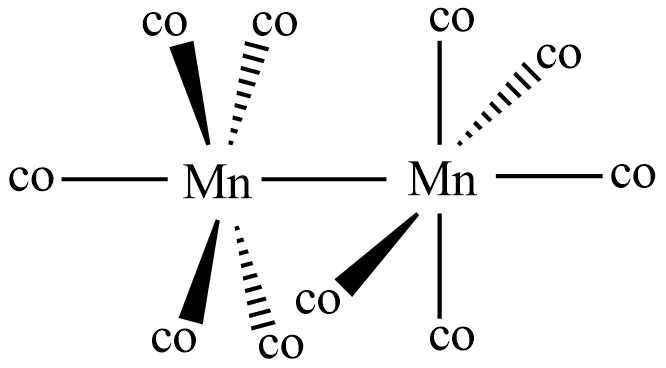
${\text{M}}{{\text{n}}_{\text{2}}}{\left( {{\text{CO}}} \right)_{{\text{10}}}}$ is an organometallic compound due to the presence of:
(A)Mn-Mn bond
(B)Mn-C bond
(C)Mn-O bond
(D)C-O bond
Answer
554.7k+ views
Hint: Organometallic compounds are formed by bonding of metals with organic moiety. Some of the d-block metals form coordination compounds with organic molecules known as organometallic compounds.
Complete Step-by-step solution:
Organometallic compounds consist of some features to be defined or regarded as organometallic compounds. The main properties include 1) There should be at least one metal to carbon atom bond in the compound, where the carbon is from organic moiety. 2) The structure of the compound has metal to metal bond.

So in the given compound ${\text{M}}{{\text{n}}_{\text{2}}}{\left( {{\text{CO}}} \right)_{{\text{10}}}}$ called as manganese carbonyl or dimanganese decacarbonyl, there occurs bonds between manganese and the carbon atoms of carbonyl group derived from sodium benzophenone ketyl. If we observe the structure of the manganese carbonyl it is seen having a bond between two manganese atoms. And also each metal atom is bonded to five carbonyl groups. This proves that ${\text{M}}{{\text{n}}_{\text{2}}}{\left( {{\text{CO}}} \right)_{{\text{10}}}}$ is an organometallic compound as it has metal-carbon atom bond.
So the answer for the above question is option (B) Mn-C bond.
Additional information: But some compounds even though having metal-carbon bonds are not considered as organometallic compounds because the carbon atom is not from an organic entity. The best examples for such compounds are Iron carbide ${\text{F}}{{\text{e}}_{\text{3}}}{\text{C}}$ and potassium ferrocyanide \[{\text{KF}}{{\text{e}}_{\text{2}}}{\left( {{\text{CN}}} \right)_{\text{6}}}\]. The best example for well-known organometals widely used as reagents in several organic reactions is Grignard reagent.
Note: In manganese carbonyl the carbonyl groups are called ligands and there are no bridging ligands in it. The two ${\text{MnC}}{{\text{O}}_{\text{5}}}$ parts occur in a staggered position in its structure to be stable.
Complete Step-by-step solution:
Organometallic compounds consist of some features to be defined or regarded as organometallic compounds. The main properties include 1) There should be at least one metal to carbon atom bond in the compound, where the carbon is from organic moiety. 2) The structure of the compound has metal to metal bond.

So in the given compound ${\text{M}}{{\text{n}}_{\text{2}}}{\left( {{\text{CO}}} \right)_{{\text{10}}}}$ called as manganese carbonyl or dimanganese decacarbonyl, there occurs bonds between manganese and the carbon atoms of carbonyl group derived from sodium benzophenone ketyl. If we observe the structure of the manganese carbonyl it is seen having a bond between two manganese atoms. And also each metal atom is bonded to five carbonyl groups. This proves that ${\text{M}}{{\text{n}}_{\text{2}}}{\left( {{\text{CO}}} \right)_{{\text{10}}}}$ is an organometallic compound as it has metal-carbon atom bond.
So the answer for the above question is option (B) Mn-C bond.
Additional information: But some compounds even though having metal-carbon bonds are not considered as organometallic compounds because the carbon atom is not from an organic entity. The best examples for such compounds are Iron carbide ${\text{F}}{{\text{e}}_{\text{3}}}{\text{C}}$ and potassium ferrocyanide \[{\text{KF}}{{\text{e}}_{\text{2}}}{\left( {{\text{CN}}} \right)_{\text{6}}}\]. The best example for well-known organometals widely used as reagents in several organic reactions is Grignard reagent.
Note: In manganese carbonyl the carbonyl groups are called ligands and there are no bridging ligands in it. The two ${\text{MnC}}{{\text{O}}_{\text{5}}}$ parts occur in a staggered position in its structure to be stable.
Recently Updated Pages
A man running at a speed 5 ms is viewed in the side class 12 physics CBSE

State and explain Hardy Weinbergs Principle class 12 biology CBSE

Which of the following statements is wrong a Amnion class 12 biology CBSE

Two Planoconcave lenses 1 and 2 of glass of refractive class 12 physics CBSE

The compound 2 methyl 2 butene on reaction with NaIO4 class 12 chemistry CBSE

Bacterial cell wall is made up of A Cellulose B Hemicellulose class 12 biology CBSE

Trending doubts
What are the major means of transport Explain each class 12 social science CBSE

Which are the Top 10 Largest Countries of the World?

Draw a labelled sketch of the human eye class 12 physics CBSE

Explain sex determination in humans with line diag class 12 biology CBSE

Give 10 examples of unisexual and bisexual flowers

State the principle of an ac generator and explain class 12 physics CBSE




